Main content starts here.
Foreign Languages > Chiba International Information Square - To foreign residents - > Chiba Nanohana News > Chiba Nanohana News (Past Issues) > Chiba Nanohana News (February 2020)
Update: February 27, 2023
Chiba Nanohana News (February 2020)
Index
I.News II . Festivals and Events III.Exhibition & Concerts
I.News
1) The Birth of Chibanian
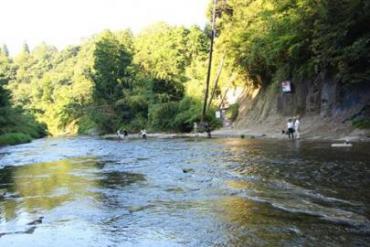
Photo: Yoro River and the Strata
Provided by Ichihara City
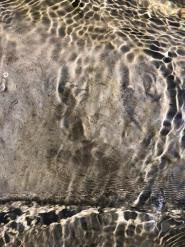
Photo: Fossils
Provided by Ichihara City
Have you ever heard of “Chibanian”? Chibanian means Chiba Era in Latin. It was decided at an International Conference to call the era which lasted from 774,000 years ago to 129,000 years ago Chibanian. This is the first time in Japanese history that such a name was given to a geologic period. The reason for this naming can be found at a rock layer in the Tabuchi district of Ichihara City in Chiba Prefecture.
The Quaternary geologic period, which includes the Chibanian era, is separated into various periods mainly by the reversal of Earth’s magnetic poles and climate change. Due to the fact that evidence of geomagnetic reversal 774,000 years ago is well recorded and the site is easy to access, the rock layer in Tabuchi was recognized as a GSSP (Global Boundary Stratotype Section and Point), and Chibanian was born.
This Chibanian Ancient Strata was the first natural monument in Ichihara City designated by the national government on October 15, 2018. The area is surrounded by the beautiful and naturally abundant Yoro River and Satoyama villages. Why not come experience this phenomena instead of reading about difficult geological concepts?
The Chibanian Visitor Center, where you are able to learn about the era, was opened on December 15, 2019, along with a nearby parking lot. An exhibition and film will be on display which explains the mechanisms of geomagnetic reversal and the strata in easy to understand terms as well as discussing fossils which can be found in the area. Be sure to make use of this facility before heading out on your geological adventure!
- Location: Chibanian Visitor Center/1157 Tabuchi, Ichihara City
- Open Hours: 9:00 - 16:00
- Closed Days: Every Thursday, December 29 - January 3 *In the event that Thursday falls on a holiday, the building will be closed on the previous day
- Access: 20 minutes by car from the Ken-O Expressway Ichihara Tsurumai Interchange
30 minutes on foot from the Kominato Railway Tsukizaki Station - Inquiries: Chibanian Visitor Center TEL: 0436-96-2755
2) Preventing Coronavirus Caused Pneumonia
Novel coronavirus pneumonia has occurred in Wuhan City, Hubei Province of China!
- Cover your mouth and nose with a mask, tissue, or handkerchief when coughing or sneezing.
- Be sure to wash your hands and gargle regularly.
- Wear a mask and immediately go to the hospital if you have been to Wuhan City and have a fever or cough.
- At the hospital, be sure to state that you have been in Wuhan City.
- Be sure to notify the quarantine station at the airport if you are returning from Wuhan City and have a fever or cough or if you are taking medication for a fever or cough.
Coronavirus/WHO
https://www.who.int/health-topics/coronavirus( External link )
II. Festivals and Events
On March 3rd every year in Japan, "Hina Matsuri" (Hina Doll Festival) or Girl's Festival is celebrated on which ornamental hina dolls are displayed to wish for girls' health and prosperity.
On this day every year, families set up a special step-altar on which to arrange their Emperor and Empress dolls, called "hina" in Japanese. They decorate this altar with boughs of peach blossoms and make offerings to the hina dolls of freshly made rice cakes (mochi), either flavored with a wild herb or colored and cut into festive diamond shapes.
1) 2020 Katsuura Big Hina Doll Festival (Katsuura City)
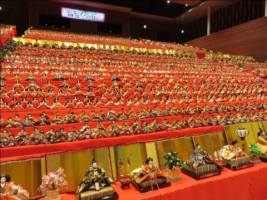
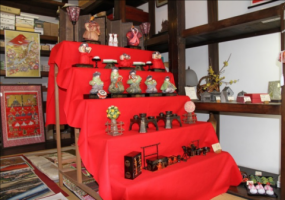
※ The "2020 Katsuura Big Hina Doll Festival" is canceled in order to prevent the spread of the New Coronavirus.
Over 30,000 hina dolls will be displayed all around Katsuura City in celebration of the hina-matsuri, or Girl’s Festival. This event first originated from efforts to hold the “Big Hina Doll Festival” (originally held in Katsuura Town in Tokushima Prefecture) in eastern Japan. Chiba’s Katsuura City has adopted 7,000 hina dolls from Katsuura Town in Tokushima.
There will be a hina doll parade featuring children in hina doll costumes, as well as a dance parade, and much more!
<Display Locations>
- Tomisaki Shrine
1,800hina dolls will line the shrine’s 60stone steps. Every day during the festival, the dolls will be put out for display in the morning and then be put away at night. (Events will be canceled in case of bad weather.) The dolls will be lit up in the evening. - Katsuura central shopping area
Here in the central shopping area located next to Tomisaki Shrine, you can find special platforms displaying the dolls, unique displays at each of the stores, and doll decorating workshops in vacant store lots. There will also be special platforms displaying the dolls at the Kakuoji Temple gates and Tona intersection. - Katsuura Art and Culture Center “Kuste”
One of the largest kyoho-bina dolls in Japan will be displayed at the Katsuura Art and Culture Center Kuste (pronounced “kyuste”). The Emperor and Empress dolls measure 120cm tall. - Other displays
Dolls will also be displayed at Okitsu Assembly Hall, Ueno Assembly Hall, Fusano Assembly Hall, tourist facilities, financial institutions, and other locations.
<hina doll parade>
- Sunday, February 23
- Time Period: Saturday, February 22- Tuesday, March 3
- Location: Tomisaki Shrine, 1Hama-Katsuura, Katsuura City
- Access: 10minutes on foot from Katsuura Station on the JR Sotobo Line
- Inquiries: Big Hina Doll Festival Planning Committee (Katsuura City Tourism and Commerce Division) TEL 0470-73-6641
2) 10th Nakayama Hina Doll Festival (Ichikawa City)
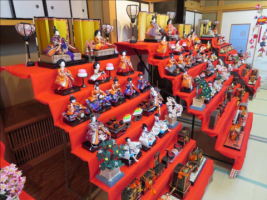
Nakayama will come alive with Hina Festival flair, all the way from the JR Sobu Line Shimosa Nakayama Station and shopping district to the Hokekyoji temple, Okunoin temple and Wakamiya.
There will be a plethora of events held during the event period, from doll displays and stamp rallies to music concerts and tea events.
Why not take a stroll through Nakayama while gazing upon the beautiful hina dolls?
- Time period: Saturday, February 15 - Tuesday, March 3, 10:00 - 16:00
- Locations: Hokekyoji Temple/2-10-1 Nakayama, Ichikawa City
Okunoin Temple/2-21-1 Wakamiya, Ichikawa City
Seikaen/4-14-1 Nakayama, Ichikawa City
Other locations - Access: Shimosa Nakayama Station on the JR Sobu Line, Keisei Nakayama Station on the Keisei Line
- Inquiries: Ichikawa Tourism/Product Information Center TEL: 047-324-7751
3) Sakura Castle Town Kimono Walk/Hina Doll Display (Sakura City)
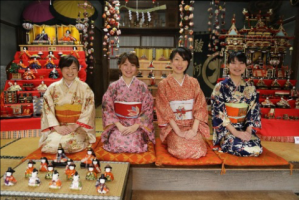
Why not take a stroll through the Sakura castle town wearing a kimono? Kimono rental and dressing services will be held from the former Hirai residence, located in old residential area of the castle town. Visitors who come dressed in a kimono will have free entry to the former residence of lord Hotta, samurai residence, and the Sakura Juntendo Memorial Hall.
During the event period, hina dolls will be on display at various shops along the Sakura castle town shopping district.
※The dolls may not be on display during closing hours/days, etc.
1) Sakura Castle Town Kimono Stroll
- Dates: February 23, March 1, 8, 15, 20, 22, 29, April 5, 12, 19
- Location: Former Hirai Residence
- Admission: Kimono rental fees/dressing service (with tea, sweets, commemorative photo present) junior high school aged and above 3,000 yen, elementary school or younger 2,000 yen, two or more elementary school or below aged children 1,500 yen per person
※Dressing service with your own kimono 2,500 yen, 1,500 yen per person if bringing your own kimono and dressing yourself - Registration: Non-profit Organization Sakura Ichirizuka TEL: 043-483-3535
- Admission day: Every Wednesday, Thursday, Saturday, Sunday 13:00 - 15:30
2) Sakura Castle Town Hina Doll Display (Sunday, February 9 - Sunday, March 8 )
- Both old and new hina dolls will be on display at the castle town shopping district.
- Location: Sakura Castle Town Shopping District Road (Sakura City Shinmachi Street)
- Access: 8 minutes on foot from the south exit of Keisei Sakura Station on the Keisei Line, 20 minutes on foot from the north exit of Sakura Station on the JR Sobu Line
- Inquiries: Non-profit Organization Sakura Ichirizuka TEL: 043-483-3535
4) Sawara Hina Dolls Display (Katori City)
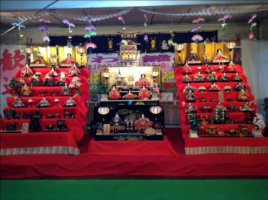
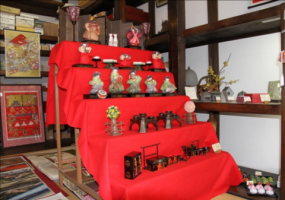
Sawara has retained its Edo Period atmosphere of being a mercantile city. You can visit Sawara’s traditional merchant houses that are a part of the “Sawara Machigurumi Museum” project, which will showcase Sawara's museum like charms, and see the treasures displayed within each house. The “Sawara Hina Doll Display” event will be held as a special exhibition of this project.
During the event period, over half of the members participating the “Sawara Machigurumi Museum” project will place their hina dolls in front of their stores, some of which are made from traditional Japanese paper or date to the Edo and Meiji periods, with some displays even depicting hina dolls inside a recreated imperial palace.
“Sawara Machinami Koryukan” (The Sawara Townscape Exchange Center) and other Facilities around the town will also be decorated with hina dolls, making the town come alive with a spring mood. Make sure to not miss this season exclusive excursion!
- Related event: Sawara Spring Hina Boat Festival, Saturday, March 7
※The "Sawara Spring Hina Boat Festival" is canceled in order to prevent the spread of the New Coronavirus.
- Time period: Saturday, February 8 - Sunday, March 22
- Location: Sawara Merchant Houses/Sawara, Katori City
- Access: 5-10 minutes on foot from the JR Narita Line Sawara Station
- URL: http://www.m-kaze.com/gurumi/( External link )
- Inquiries: Sawara Landlady society TEL: 080-5455-7577
5) Sakata Castle Ruins Plum Festival (Yokoshibahikari Town)
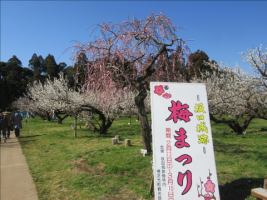
※ The "Sakata Castle Ruins Plum Festival" is canceled in order to prevent the spread of the New Coronavirus.
With over 1,000 gargantuan plum trees aged over 50 years, the Sakata Castle Ruins are known as one of the largest plum grove in the prefecture. The dignified white flowers all blooming at once is truly a breathtaking sight.
The Sakata Castle Ruins, site of the plum grove, was a middle-ages style castle built in the Muromachi Period by the Chiba family. This castle was built with a number of "Kuruwa" (enclosures), having survived for over 400 years without it being destroyed even once, leaving its original form intact making it a precious relic for Chiba Prefecture. You begin to see the majestic old plum trees after passing the earthworks with a cedar grove and castle moat.
During Saturdays, Sundays, and Holidays during the event period, various goods, food/drinks, processed plum goods will be sold at the central square of the plum grove, as well as a plum seed spitting contest and Nabana picking. Zoni soup will also be given out as presents.
A “Ekikara Hiking” will also be held in conjunction with this event, which is a walk from the JR Sobu Line Yokoshiba Station to the festival grounds.
※There will be a temporary parking lot and shuttle bus in operation on Saturdays, Sundays, and Holidays during the event period.
- Time period: Saturday, February 22 - Sunday, March 8
- Location: Inside the Sakata Castle Ruins Plum grove/ Sakata, Yokoshibahikari Town
- Access: 10 minutes by taxi from the JR Sobu Line Yokoshiba Station or 45 minutes on foot
- Inquiries: Sakata Castle Ruins Plum Festival Executive Committee TEL: 0479-74-8585
6) Yoritomo Sakura Festival (Kyonan Town)
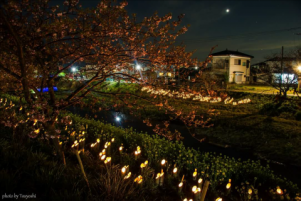
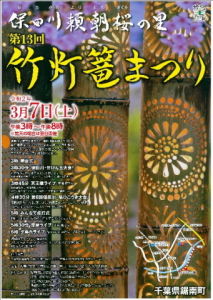
Kyonan Town announced that the Sakura (cherry blossoms) began blooming on January 20. The town suffered large damage in the wake of last fall's typhoons, but recovery efforts are underway with the town also placing emphasis on tourism.
Minamoto no Yoritomo (a famous shogun from the Kamakura period) lost the battle of Ishibashiyama and fled to Awa’s Ryushima (currently known as Kyonan Town) by small boat to plan his comeback. The “Kawazu Zakura” were renamed to “Yoritomo Sakura” in honor of this historical fact, and the town is currently aiming to be Japan’s #1 Sakura viewing location, actively continuing to plant new trees.
Currently, there are 14,000 Yoritomo Sakura trees planted within the town, with 600 trees along the Hota River, 400 at the Sakuma Dam Park, and 400 along the Sakuma River.
“The Hota River Yoritomo Sakura Bamboo Lantern Festival” will be held on March 7. You don’t want to miss the otherworldly sight of the Sakura being lit up with over 2000 candles from handmade bamboo lanterns.
Hota River Yoritomo Sakura Bamboo Lantern Festival
※The "Hota River Yoritomo Sakura Bamboo Lantern Festival" is canceled in order to prevent the spread of the New Coronavirus.
Date and time: Saturday, March 7, 15:00-20:00 *moved to next day in the event of bad weather
※lighting ceremony from 17:00
- Location: along the Hota River, between the Gongen/Tenno Bridges
Yoritomo Sakura Festival
- Time period: Saturday, February 15-Sunday, March 8
- Location: Hota River, Sakuma Dam Park/39 Okuzure, Kyonan Town
- Access: Hota River: 10minutes on foot from the Hota Station on the JR Uchibo Line
3minutes after turning left off of Prefecture Highway 34off of Futtsu Tateyama Road Kyonan Hota Interchange (Parking lot available)
Sakuma Dam Park: 30minutes on the town bus departing from Awa-Katsuyama Station on the JR Uchibo Line, getting off at the “Sakuma Dam Koen Iriguchi” stop
10minutes after turning left at the light off of the Futtsu Tateyama Road Kyonan Tomiyama Interchange (Parking lot available) - Inquiries: Kyonan Town Tourism Association (Tourism Center directly in front of Hota Station) TEL: 0470-55-1683
III. Exhibitions & Concerts
※Prefectural museums will be closed from March 3, 2020 to March 15, 2020 to prevent the spread of the new Coronavirus.
The closing period may be extended depending on the situation.
1) Ch_AIR - Chiba Prefectural Museum of Art: Artist in Residence Josephine Vejerich Watanabe (Chiba City)
The Chiba Prefectural Museum of Art supports artists in residence. The artist in residence’s work are displayed, and workshops which express the appeal of Chiba Prefecture’s history, geography, and culture. The artist currently in residence is Joséphine Vejerich Watanabe from Sweden, known by her nickname Jojo.
Jojo lived in Yamanashi Prefecture until 2019, where she published collages, illustrations, and pottery artwork. In this exhibit, the artist will actually stay in the museum and paint on the large window of the 7th Exhibit Hall while also displaying her past works while describing her work as an artist.
- Time period: Tuesday, January 28 - Sunday, April 12 The artist will present for 5 days during the event period.
- Location: Chiba Prefectural Museum of Art 7th Exhibit Hall/1-10-1 Chuoko, Chuo-ku, Chiba City
- Admission: Free for 7th Exhibit Hall
- General Admission for the Museum: General 300 yen, High school/university students 150 yen, Ages 65 and above, junior high school or younger, and those with a disability certificate and 1 caretaker free
- Access: 10 minutes on foot from Chiba Minato Station on the JR Keiyo Line or Chiba Urban Monorail
- URL: http://www.chiba-muse.or.jp/ART/( External link )
- Inquiries: Chiba Prefectural Museum of Art TEL: 043-242-8311
2) Spring Exhibit: Plums, Peaches, and Cherry Blossoms (Natural History Museum and Institute, Chiba)

Time period: Saturday, February 15 - Sunday, May 17
There is a special place in Japanese peoples’ hearts for plums, peaches, and cherry blossoms, three plants which symbolize spring. These similar yet different plants will be showcased from a scientific and cultural viewpoint through the use of various specimens and ukiyo-e.
Related Events:
Viewing Party: Plum Viewing Party (50 yen insurance fee, required for entering)
A plum viewing party will be held in Aobanomori Park after the exhibition is explained.
- Date and time: Sunday, February 16 13:30 - 15:30
- Location: Natural History Museum and Institute, Chiba, 2nd Planned Exhibition Room, Aobanomori Park
- Eligible Participants: Anyone middle school aged and above
- Capacity: 30 people (same-day registration, first-come first-serve basis)
Lecture: "Are Sumomo Plums and peaches Actually Cherry Blossoms?" (Free, no admission fee required)
Toshio Katsuki, a botanist from the Tama Forest Science Garden and author of many written works on cherry blossoms, has been invited to speak about plant varieties similar to cherry blossoms and what to look out for when viewing cherry blossoms.
- Date and time: Sunday, February 23 (Holiday) 13:30 - 15:00
- Location: Natural History Museum and Institute, Chiba, Lecture Hall
- Eligible Participants: Anyone *Elementary school aged and younger children must be accompanied by parent or guardian
- Capacity: 150 people (same-day registration, first-come first-serve basis)
Museum Talk: (Free, no admission fee required)
- Date and time: Saturday, February 15, Saturday, February 29 11:00 - 14:30
- Location: Natural History Museum and Institute, Chiba, 2nd Planned Exhibition Room
- Eligible Participants: Anyone *Elementary school aged and younger children must be accompanied by parent or guardian
- Capacity: 150 people (same-day registration, first-come first-serve basis
- Museum Hours: 9:00 - 16:30(last entry 16:00)
※Closed Monday(if Monday falls on a holiday, it will be open and closed the following day) - Location: 955-2 Aobacho, Chuo-ku, Chiba City (inside the Aoba no Mori Park)
- Admission: General Admission: 300 yen (240 yen), High School/University Students 150 yen (120 yen)
※Prices in parentheses are group prices (20 or more people)
※Middle school and below, aged 65 and above, disabled person and their 1 caretaker free - Access: 15 minutes by bus from JR Chiba/Soga Stations, get off at “Chuo Hakubutsukan” stop and 7 minutes on foot.
20 minutes on foot from the Keisei Chibadera station. - URL: http://www2.chiba-muse.or.jp/NATURAL/( External link )
- Inquiries:Natural History Museum and Institute, Chiba TEL: 043-265-3111
HOME Back to top I.News II.Festivals and Events III.Exhibition & Concerts
